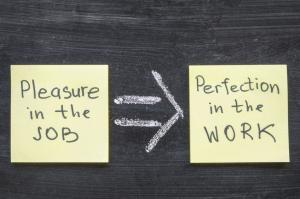HFI-U Releases Brief on How to Build Good Facility Health Habits
Just as fish “discover” water last due to their immersion in it, it’s helpful for us to grasp the sea of habits in which we’re immersed, so we can change them.
NAMPA, ID, US, December 9, 2019 /EINPresswire.com/ -- HFI-U, as part of its educational outreach, is providing tips to assist operations personnel to develop good facility health habits by raising awareness of these behaviors and our ability to change them.
Per the Society for Personality and Social Psychology, 40% of our daily choices are habits.
“Habits are like the water in which fish swim,” said Allen Rathey, principal of HFI-U. “And there is truth to the saying, ‘fish discover water last’. Much of life consists of habit—we are ‘swimming’ in it—and we are wise to examine this ‘current’ to ensure it will move us toward our goals.”
MIT researchers found each habit consists of three parts:
1. A Cue – A trigger that prompts an action, switching our brains to “automatic mode”.
2. A Routine – An action, process, or behavior prompted by a cue.
3. A Reward – A desire or motivation integrated in the cue and the action it prompts.
Research shared by author Charles Duhigg in his book, The Power of Habit: Why We Do What We Do in Life and Business―reveals you can change a habit if you replace #2 (the routine) with a different one and keep the same or similar cue and reward (#1 and #3).
Example:
1. Cue: Place your workout clothes, shoes, and hydration pack by the door.
2. Routine: Jog/run for 45 minutes.
3. Reward: Enjoy the endorphin rush, the peaceful feeling that results from a workout, and a cup of your favorite herb tea.
To change this habit, you would keep the cue and reward, and change the routine (e.g., substituting weightlifting for running).
Of course, it’s rarely as simple as that, so it helps to begin with overarching “domino” or keystone habits, then integrate the habits in a systemic approach.
Keystone Habits Drive Change
Keystone Habits are “behavior influencers” that help change other habits. These high-leverage habits create a domino or ripple effect.
We know the importance of keystone health habits such as:
Exercise
Nutritious Diet
Positive Thinking
These habits are most effective as a system―as they positively affect each other―working synergistically and not as isolated parts. For example, if you exercise your body, what happens to your mind? It works better because of increased blood flow and other factors. Working a muscle does what? It makes it stronger, and often improves your mood. Proper diet provides the nutrients and energy for exercise and muscle growth, mental health, and alertness.
Keystone Habits also relate to culture.
In 1997, Alcoa-aluminum CEO Paul O'Neill, launch a cultural change that became a keystone habit: He made worker safety―not revenue or profit―Alcoa’s #1 priority. While the initial reward for Alcoa’s safety habit was the satisfaction of a safer workplace, “domino habits” from scrutinizing manufacturing processes to prevent injury raised morale, efficiency, and revenue by 5x.
Similarly, making healthy indoor spaces a keystone habit puts a focus on processes that remove unwanted matter from the environment and eliminating those that redistribute or add pollutants. This is not only healthier and more hygienic, but raises staff morale, quality, and labor-savings.
For example, processes that capture rather than spread dust reduce exposure to airborne dust and asthma triggers, and lower labor for dusting.
A healthy facility cleaning habit raises the quality of cleaning, productivity, and―accompanied by education―staff pride in ensuring a healthier environment.
In the words of Aristotle: “We are what we repeatedly do. Excellence is not an act, but a habit.” Given the importance of indoor environments to health and productivity, isn’t it time to ensure our habits are driving excellence?
For more information on the role of habits in improving the health of indoor spaces, visit: https://www.hfi-u.org/checklists-and-habits.
Allen Rathey
HFI University (HFI-U)
+1 208-724-1508
email us here
Legal Disclaimer:
EIN Presswire provides this news content "as is" without warranty of any kind. We do not accept any responsibility or liability for the accuracy, content, images, videos, licenses, completeness, legality, or reliability of the information contained in this article. If you have any complaints or copyright issues related to this article, kindly contact the author above.



